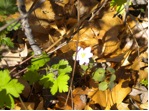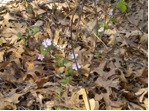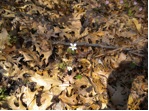Rue Anemone
Contact
Katharine Ordway Natural History Study Area9550 Inver Grove Trail Inver Grove Heights, MN 55076 651-455-6204 (On Site)
651-696-6230 (On Campus)
andersonm@macalester.edu
Biotic Inventory: Documenting Diversity at the Katharine Ordway Natural History Study Area
Thalictrum thalictroides, Rue Anemone



Taxonomy
Kingdom Plantae
Division Magnoliophyta
Class Magnoliopsida
Order Ranunculales
Family Ranunculaceae
Genus Thalictrum
Species thalictroides
Common Name: Rue Anemone
Diagnostic Characteristics
There are many ways to go about identifying a wildflower, many of which revolve around the flower itself. The rue anemone, unlike many other flowers, has a varying number of what appear to be petals (they are actually sepals); there can be anywhere between 5 to 10 of them1. These sepals can be either white or pink; reportedly, white is much more common4, but there seemed to be more pink than white within Ordway. Within the flower, the stamens are yellow and extremely numerous4.
The leaves can also provide key information for identifying flowers. The rue anemone has very distinct leaves, with two forms of them. On the stems which end in flowers, the leaves have three lobes on the end, which roughly resemble an animal paw; on the stems which don’t end in flowers, the leaves can have additional lobes1. In either case, the sections of the stem carrying the leaves come together in whorls, usually in groups of three or four2. The stems are smooth, and the whole plant usually grows to a height of 10 to 30 cm (or 4-8 inches)5.
Ecology
The rue anemone is able to tolerate shade, and as such lives in forested environments. It is one of the first flowers to bloom in the springtime, opening in March and blooming until June2. The plant is developed commercially, as the flowers themselves can be quite attractive3. The plants are poisonous to humans when consumed in large amounts, but there appear to be some health benefits associated with them3. In particular, the Cherokee used infusions of the plant as a cure for vomiting and diarrhea2.
Life History
The rue anemone, being an angiosperm, gives rise to seeds which, in turn, give rise to the sporophyte plant itself. However, the plant is a perennial; this means that the plant will live several years, and will not flower every year. Seeds planted will flower in their second or third year3.
Distribution
The rue anemone is found throughout much of the eastern United States, as well as parts of Ontario, Canada. It is found all along the East Coast, from Maine to Florida, and as far west as parts of Kansas, Oklahoma, and Texas. Their northwestern limit is Minnesota. It is not present on any other continent. While it is not a protected species federally, a few states have given it a form of protected status; Florida lists it as endangered, New Hampshire as threatened, Maine as possibly extirpated, and Rhode Island lists it as a species of special concern6.
Voucher Information
The specimen was collected on April 15, 2010, at the Katherine Ordway Natural History Study Area in Inner Grove Heights, MN. The patch of woods the specimen was collected from is right next to the railroad tracks, and the flowers were growing along a trail. There was significant leaf litter around the area, and the area was dry.

References
Discover Life in America. 2010. http://www.dlia.org/atbi/species/Plantae/Magnoliophyta/Magnoliopsida/Ranunculales/Ranunculaceae/Thalictrum_thalictroides.shtml
Flora of North America. 2010. http://www.efloras.org/florataxon.aspx?flora_id=1&taxon_id=233501276
Lady Bird Johnson Wildflower Center. 2010. http://www.wildflower.org/plants/result.php?id_plant=thth2
Minnesota Wildflowers. 2010. http://www.minnesotawildflowers.info/flower/rue-anemone
Robert W. Freckman Herbarium. 2010. http://wisplants.uwsp.edu/scripts/detail.asp?SpCode=thatha
USDA NRCS PLANTS Profile. 2010. #http://plants.usda.gov/java/profile?symbol=THTH2
Images
Additionally, there is a pressing of the plant available.
Compiled by Matthew Vance.
Biodiversity & Evolution (BIOL 270) Professr Sarah Boyer. Spring 2010.
Specimen collected at Macalester College’s Katharine Ordway Natural History Study Area on April 15, 2010.